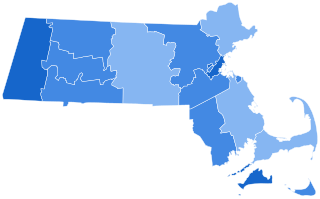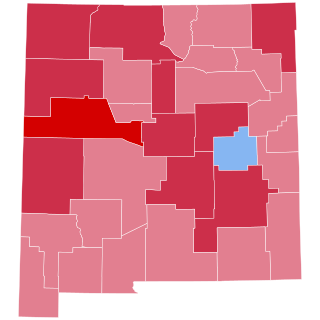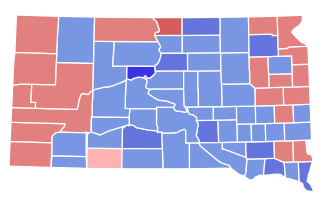
The 70th United States Congress was a meeting of the legislative branch of the United States federal government, consisting of the United States Senate and the United States House of Representatives. It met in Washington, D.C., from March 4, 1927, to March 4, 1929, during the last two years of Calvin Coolidge's presidency. The apportionment of seats in the House of Representatives was based on the 1910 United States census.

Lester Jesse Dickinson was a Republican United States Representative and Senator from Iowa. He was, in the words of Time magazine, "a big, friendly, white-thatched Iowa lawyer." In early 1936, he dreamed of winning the presidency. However, the only race he would enter that year would be for his own seat in the Senate which he lost.

The 2004 United States presidential election in Massachusetts took place on November 2, 2004, and was part of the 2004 United States presidential election. Voters chose 12 representatives, or electors to the Electoral College, who voted for president and vice president.
The Massachusetts Republican Party (MassGOP) is the Massachusetts branch of the U.S. Republican Party.

John Hammill served three terms as the 24th Governor of Iowa from 1925 to 1931.
Lorenzo W. (L.W.) Housel was a Connecticut state legislator who later ran for Congress and statewide office in Iowa. Running as a Democrat in an era in which Republicans dominated Iowa politics, Housel was unsuccessful in each of his Iowa races.

The 1928 United States presidential election in New Mexico took place on November 6, 1928. All contemporary forty-eight states were part of the 1928 United States presidential election. State voters chose three electors to represent them in the Electoral College, who voted for president and vice president.

The 1928 New Jersey gubernatorial election was held on November 6, 1928. Republican nominee Morgan Foster Larson defeated Democratic nominee William L. Dill with 54.88% of the vote.

The 1924 United States Senate election in New Jersey was held on November 4, 1924. Incumbent Republican Senator Walter Evans Edge was re-elected to a second term in office. He would not complete the term, resigning from office in 1929 to be sworn in as the U.S. Ambassador to France.

The 1928 United States Senate election in Michigan was held on November 6, 1928 alongside a special election to the same seat.

The 1928 United States Senate election in Wisconsin was held on November 6, 1928.

The 1928 Massachusetts gubernatorial election was held on November 6, 1928.

The 1934 Massachusetts gubernatorial election was held on November 6, 1934.

The 1932 Iowa gubernatorial election was held on November 8, 1932. Democratic nominee Clyde L. Herring defeated incumbent Republican Dan W. Turner with 52.77% of the vote.

The 1928 Ohio gubernatorial election was held on November 6, 1928. Republican nominee Myers Y. Cooper defeated Democratic nominee Martin L. Davey with 54.79% of the vote.

The 1926 Iowa gubernatorial election was held on November 2, 1926. Incumbent Republican John Hammill defeated Democratic nominee Alex R. Miller with 71.51% of the vote.

The 1924 Iowa gubernatorial election was held on November 4, 1924. Republican nominee John Hammill defeated Democratic nominee James C. Murtagh with 72.72% of the vote.

The 1928 South Dakota gubernatorial election was held on November 6, 1928. Incumbent Democratic Governor William J. Bulow ran for re-election to a second term. In the general election, he faced Attorney General Buell F. Jones, the Republican nominee. Despite Republican presidential nominee Herbert Hoover overwhelmingly defeating Democratic nominee Al Smith overwhelmingly in South Dakota, Bulow defeated Jones by a decisive margin to retain the governorship. In so doing, he became the first Democratic candidate for Governor to receive a majority of the vote in the state's history.

The 1928 Missouri lieutenant gubernatorial election was held on November 6, 1928. Republican nominee Edward Henry Winter defeated Democratic nominee Frank Gaines Harris with 52.47% of the vote.

The 1928 Illinois lieutenant gubernatorial election was held on November 6, 1928. Incumbent Republican liuetenant governor Fred E. Sterling was reelected to a third consecutive term.



















